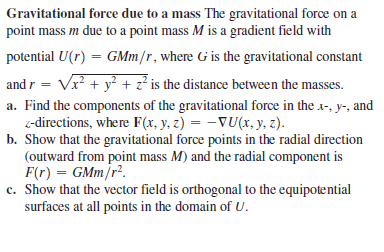Gravitational force due to a mass The gravitational force on a point mass m due to a point mass M is a gradient field with potential U(r) = GMm/r, where G is the gravitational constant %3D and r = Vx? + y? + z² is the distance between the masses. a. Find the components of the gravitational force in the x-, y-, and z-directions, where F(x, y, z) = –VU(x, y, z). b. Show that the gravitational force points in the radial direction (outward from point mass M) and the radial component is F(r) = GMm/r². c. Show that the vector field is orthogonal to the equipotential surfaces at all points in the domain of U.
Gravitational force due to a mass The gravitational force on a point mass m due to a point mass M is a gradient field with potential U(r) = GMm/r, where G is the gravitational constant %3D and r = Vx? + y? + z² is the distance between the masses. a. Find the components of the gravitational force in the x-, y-, and z-directions, where F(x, y, z) = –VU(x, y, z). b. Show that the gravitational force points in the radial direction (outward from point mass M) and the radial component is F(r) = GMm/r². c. Show that the vector field is orthogonal to the equipotential surfaces at all points in the domain of U.
Related questions
Question

Transcribed Image Text:Gravitational force due to a mass The gravitational force on a
point mass m due to a point mass M is a gradient field with
potential U(r) = GMm/r, where G is the gravitational constant
%3D
and r = Vx? + y? + z² is the distance between the masses.
a. Find the components of the gravitational force in the x-, y-, and
z-directions, where F(x, y, z) = –VU(x, y, z).
b. Show that the gravitational force points in the radial direction
(outward from point mass M) and the radial component is
F(r) = GMm/r².
c. Show that the vector field is orthogonal to the equipotential
surfaces at all points in the domain of U.
Expert Solution
This question has been solved!
Explore an expertly crafted, step-by-step solution for a thorough understanding of key concepts.
This is a popular solution!
Trending now
This is a popular solution!
Step by step
Solved in 3 steps with 9 images
